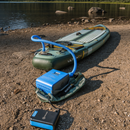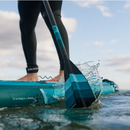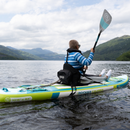What Is Paddle Boarding? Its Benefits, and How to Get Started?

Have you ever dreamed of standing on water? Paddle boarding - officially known as stand-up paddle boarding can make that dream a reality. With this fun water activity, you may glide across a variety of water surfaces, from calm lakes to gently rolling ocean waves. If you are wondering “what is paddle boarding?” and what makes it so popular, let's dig into the topic of paddle boarding to explore its key features, history, essential gear, and useful beginner tips through the article below.
What Is Paddle Boarding?
Paddle boarding, or stand-up paddle boarding (SUP), is a water sport that involves standing on a large, stable board and using a single-bladed paddle to propel yourself across the water.
The basic premise is simple – you stand upright on a specially designed paddle board and use a long paddle to push yourself forward. This creates a peaceful, low-impact activity combining surfing, canoeing, and kayaking elements. Paddle boarding provides a unique way to explore waterways, get exercise, and connect with nature.
Next, what does a paddle board look like? Paddle boards come in a variety of shapes and sizes, but they generally have a long, flat, and wide design to provide stability and buoyancy on the water. They often have a tapered nose and tail, and many feature a textured deck to help with traction and grip.
Is Paddle Boarding Difficult?
After already understanding “what is SUP paddle board?" you might be surprised to discover that paddle boarding is actually quite simple! Lots of people can learn it in just one day. Once you can balance and paddle a bit, you're good to go. So, don't worry, just try it! And if you're good at this playground, bring a friend who's new. They soon will quickly appear to be pros fast!

History of Paddle Boarding
This section will present some insights on the question of what is a stand up paddle board’s history. The origins of SUPing can be traced back thousands of years. When looking into the history of SUPing, many believe its modern revival began in Hawaii in the early 2000s. The roots of this watersport stretch across the globe.
Some of the earliest evidence of stand-up water activities comes from ancient Peruvian fishermen, who used reed boats called “Caballito de Totora” to paddle out and ride the waves back to shore. Similarly, gondoliers in Venice have long used elongated oars to propel themselves while standing on their boats.
In Israel, local fishermen and lifeguards used a boat called a “hasake” to paddle through the surf while standing upright. This Mediterranean tradition is seen as an early ancestor of modern stand-up paddling.
The breakthrough moment is often cited as the time when Hawaiian watermen Dave Kalama and Laird Hamilton started using paddles with their longboards in the early 2000s. This sparked a resurgence of interest and helped popularize stand-up paddle boarding as we know it today. However, the sport's history extends far beyond this recent revival, with ancient practices from around the world laying the foundation for the modern paddle boarding craze.
What Are Paddle Boarding’s Benefits?
Many folks might wonder what SUP paddle board’s good sides are. Besides being an immensely enjoyable outdoor hobby, stand up paddle boarding provides a wide range of life-changing health benefits, as listed below:
1. Reduces Your Stress Levels
Paddle boarding can help you feel less stressed because being on the water is calming. It can also be exciting and distract you from stress, even if you fall off. Just being by yourself on the water and breathing in the salty air will make you feel much better. It's hard to think about your problems when you're holding your paddle.
2. Paddle Boarding in Flat Water
When the water is calm and the waves are nowhere to be found, paddle boarding is absolutely a good choice. If you don't want to surf but still want to be on the water, then paddle boarding is a strong backup plan to enjoy your day.
3. Lose Weight
Everybody wants to drop those extra pounds pronto, but crash diets and magic pills aren't the way to go. Instead, it would help if you looked to paddle boarding to help with those weight loss goals. Research says it's better at burning fat than ingesting those dodgy diets or pills. Plus, paddle boarding is a blast type of exercise, so why not give it a shot?
4. Increases core strength
Building up your core isn't just about getting rid of back pain. It also helps shield your insides, keeps you from getting hurt, and keeps your posture in check. Stand-up paddle boarding is a fun way to beef up your core muscles. As you get better at paddling, you'll notice big changes in your core strength. Your core muscles are like the body's stabilizers. By mastering balance on your paddle board, you're giving your core a workout without even trying. It's a cool way to make those muscles do what they're meant to do.
5. Enhances Joint Stability
Paddle boarding is also a killer workout for your whole body. Balancing and paddling use a bunch of muscles, like your core, back, shoulders, legs, and even your calves. This helps make your joints stronger and steadier. On top of that, if you throw in some SUP yoga, you're hitting even more muscles. So forget boring gym sessions—paddle boarding is where it's at for a full-body workout that never gets old!
6. Full Body Workout
Believe it or not, using a SUP inflatable paddle board takes your full-body gig. As you paddle, you're giving your back, core, arms, legs, shoulders, and torso a workout. Trying to stay balanced on the board makes your body work extra hard. And as your heart pumps faster, your blood vessels open up, they will send more oxygen to your brain and keep your whole body in top shape.
7. Boost Endurance
If you're into building your endurance, give SUP a shot! It's a fantastic way to up your game. As you get stronger, fitter, and better at paddling, you'll find yourself going further and faster.
What's cool is, you're in charge of how hard you push. You can aim for targets and aim to beat your own records. Just like jogging or running, you can create a schedule that suits you.
8. Get Vitamin D
Getting a bit of sun has loads of health perks, like ramping up your Vitamin D levels, lifting your spirits, and even tackling annoying seasonal affective disorder blues (SAD). Paddle boarding is a fabulous way to soak up some rays and enjoy the outdoors.
But remember, don't go overboard with sun exposure, especially when you're out on your board. While catching some rays is good, finding a balance is important. Make sure to wear enough and proper sunscreen and cover those sensitive spots carefully.
Types of Paddle Boarding Activities
If you're new to stand-up paddle boarding, you might be curious what is stand up paddle boarding's common activities are. Let’s explore a wide range of fun experiences jotted down below:
- Surfing: Surfing on a SUP board gives you that thrilling rush. It takes skill, balance, strength, and know-how about the waves and surf rules. It's tough but super satisfying.
- Fishing and Crabbing: SUP fishing is a fantastic way to enjoy the water and scout out your go-to fishing spot. Just like SUP fishing, it's a neat spot to nab some crabs too. You can set out crab pots, paddle around, and check back later.
- Yoga: SUP yoga blends paddle boarding with yoga moves. You'll do yoga poses on the board, which adds a bit of extra challenge and demands good balance and stability.
- Whitewater: River and whitewater SUP brings diverse challenges, such as rapids, currents, and natural obstacles. You need specific skills and gear to navigate these changing environments.
- Racing: SUP racing is the most competitive type of SUP activity, emphasizing technique, speed, and stamina. Races come in different lengths and styles, from technical races to fast sprints, open-water downwind challenges, and ultra-endurance competitions.
- Touring: What paddle boarding touring means, is that they explore longer distances on a specially shaped touring paddle board. You'll often glide along rivers, canals, or coastal paths.
- Snorkeling and Diving: Bringing a SUP along on a snorkeling adventure lets you paddle along unexplored coastlines, observing untouched marine ecosystems. Diving from SUPs is also gaining popularity due to their ease of use.
- Exercise: SUP fitness includes workouts on the board focused on building strength, balance, and cardio. They could be a blend of yoga, pilates, and other exercises.
- Play With Kids: Paddling with your children outside is a way for them to paddle on their own board or prefer hitching a ride on yours, also lets you bond without screens.
- Take Your Dog: Taking your furry friend paddle boarding is a fantastic way to have a water adventure together and strengthen your bond with your loyal canine companion.
- Photography: If you love photography, paddling on a SUP lets you reach hidden spots and capture scenes unseen by most.
- Meditation: Meditating on a paddle board is like yoga without the physical exertion. Drifting on the open water, surrounded by nature's peaceful sounds, allows you to unwind and destress..
- Sunbathing: Opting for sunbathing on an inflatable SUP is ideal because of its soft, comfy surface. If you start feeling too warm on your board, a quick dip in the water nearby can help cool you down.
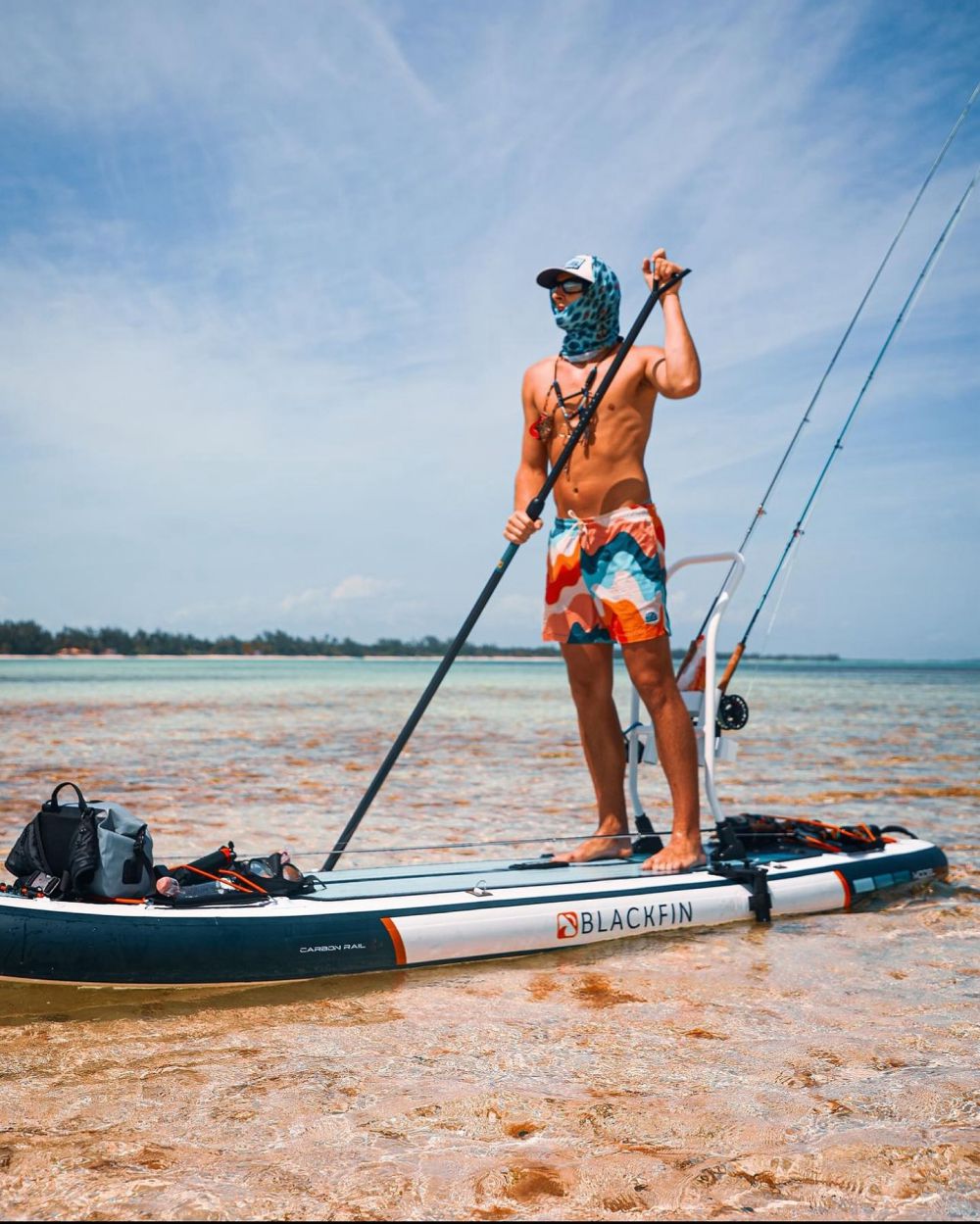
Tips for Starting Paddle Boarding
If you've never paddle boarded before, have a look at these crucial pointers to get your amazing adventure started:
- Always wear a SUP leash and personal flotation device for added safety on the water.
- Choose the right gear based on your skill level and the type of water you'll be paddling on.
- Wear suitable clothing for the weather and water temperature.
- Begin on calm waters like lakes until you're comfortable standing and balancing on the board.
- Focus on using your core muscles, not just your arms.
- Locate the center grab handle, which marks the middle of the board.
- Begin by kneeling until you feel comfortable standing up.
- Keep your knees slightly bent and focus on looking ahead when transitioning to standing.
- Point the angled side of your paddle blade away from you, towards the front of the board, for the most effective strokes.
- Start paddling into the wind to make the return trip easier, especially when you're tired.
- If you're about to fall, try to fall away from the board to avoid injury.
3 Main Types of Paddle Boarding
After getting the answer for "what is a sup paddle board”, let's start by discussing how stand-up paddle boards are made. Each type has its own advantages, suited for different people and activities. Here are the three main types:
1. Hard Paddle Boards
These boards are made using epoxy resin and fiberglass. They usually have an EPS foam core wrapped in layers of fiberglass with an epoxy resin coating. Some even have carbon fiber rails for extra strength, durability, and a lightweight feel.
Hard SUPs are great for slicing through water and moving smoothly. They offer precise control, perfect for riding waves and maneuvering. With less resistance, they can also pick up speed easily, depending on their shape.
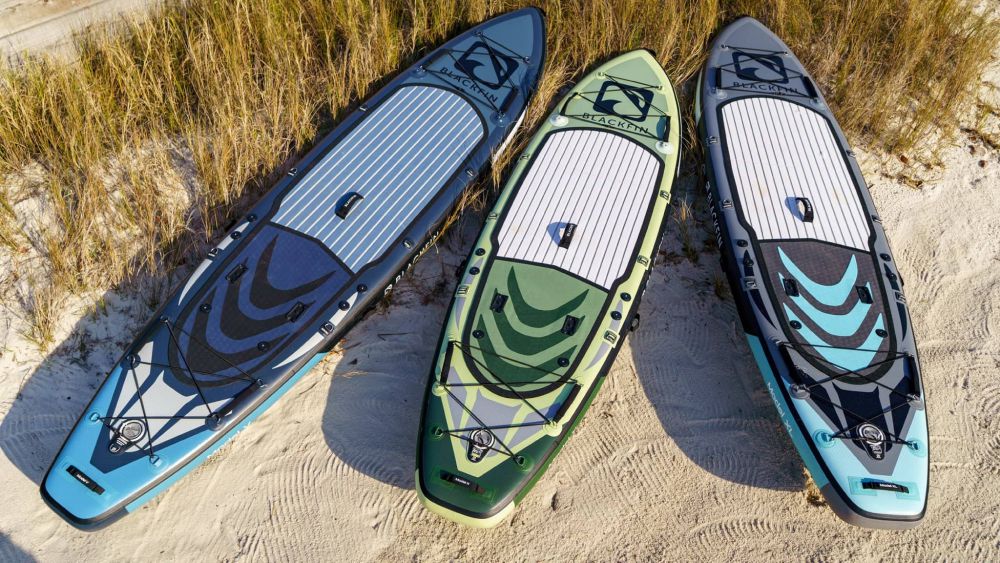
Hard boards can be challenging for beginners because they respond closely to your movements. They are better suited for experienced riders. While hard SUPs have their benefits, they can be tricky to transport and store due to their size. They also tend to be pricier because of their longer manufacturing process.
Seasoned paddlers can check out iROCKER’s top picks for Hard Paddle Boards!
2. Soft Top Paddle Board
Soft-top paddle boards are crafted similarly to epoxy boards, featuring a foam core layered with soft material for added cushioning. This design makes them resilient against scuffs and dings, ideal for paddle boarding and surf schools. While they may not match the performance of other boards, their versatility shines through. They're excellent for families and beginners encountering rough waters or learning the ropes of paddle boarding. Their durability also makes them suitable for bringing pets.
However, their added padding contributes to their heavier weight, and the polyethylene layer on the bottom can be prone to damage. Despite these drawbacks, soft top paddle boards offer an affordable entry point into the sport, making them a reliable choice for beginners.
3. Inflatable Sup Boards
In recent years, inflatable SUP boards have surged in popularity thanks to advancements in quality. Contrary to misconceptions, these boards are not made from cheap materials. Modern construction techniques and materials, such as heavy-duty PVC and drop-stitch technology, ensure durability and performance comparable to fiberglass options.
When properly inflated, inflatable SUPs feel rigid and stable, matching epoxy boards. They excel in durability, withstanding rough conditions while offering excellent stability on the water. Although they may not glide as swiftly as fiberglass SUPs, they compensate with convenience. Their compact size, when deflated, makes them ideal for transportation and storage, easily fitting into the included backpack.
Inflatable paddle boards are perfect for adventurers who want to travel with their SUP. They offer reliable all-around performance. A wide variety of inflatable boards are available, catering to different skill levels, versatility, performance, and preferred activities.
At iROCKER’s store, adventure awaits everyone! Explore our top picks for the best Inflatable Paddle Boards and embark on your next thrilling journey!
Paddle Boarding Time!
We trust you've found this article on the concept of what is paddle boarding means. Stand up paddle boarding is a whole new, incredibly fantastic way to boost your overall well-being. It's a versatile sport that caters to your preferences, whether you crave a serene paddle at sunrise or an exhilarating ride in the waves. Its safety, gentle impact, and universal appeal contribute to its increasing popularity year after year.

If you haven't tried paddle boarding yet, we urge you to give it a go. We bet you'll be hooked after your first paddle! Ready to start your own paddle boarding adventure? Explore top-quality gear and accessories at iROCKER's store today and take your paddling experience to the next level!
Happy and healthy paddling!




